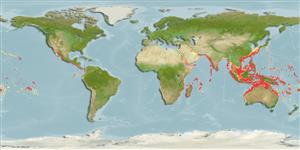>
Mulliformes (Goatfishes) >
Mullidae (Goatfishes)
Etymology: Parupeneus: Latin, parum, parvum = small + Peneus, the name of a river.
More on author: Lacepède.
Environment: milieu / climate zone / depth range / distribution range
นิเวศวิทยา
เกี่ยวกับทะเล,น้ำเค็ม; กร่อย เกี่ยวกับหินโสโครก; ระดับความลึก 12 - 350 m (Ref. 37816), usually ? - 60 m (Ref. 1602). Tropical; 35°N - 33°S
Indo-West Pacific: Red Sea and east coast of Africa to the Caroline Islands and Fiji.
ขนาด / น้ำหนัก / Age
Maturity: Lm ? range ? - ? cm
Max length : 36.0 cm TL เพศผู้/กระเทย; (Ref. 11441); common length : 25.0 cm TL เพศผู้/กระเทย; (Ref. 9947); น้ำหนักสูงสุดที่มีการรายงาน: 877.00 g (Ref. 125599); อายุสูงสุดที่ได้รายงาน: 6 ปี (Ref. 86367)
เงี่ยงครีบหลัง (รวม): 8; ก้านครีบอ่อนที่หาง (รวม): 9; เงี่ยงครีบก้น 1; ก้านครีบอ่อนที่ก้น: 7. Diagnosis: Pectoral rays 16 (rarely 15 or 17). Gill rakers 6-7 + 29-23 (total 26-30). Body depth 2.95-3.55 in SL; head length (HL) 2.9-3.25 in SL; snout length 1.75-2.1 in HL; barbel length 1.15-1.35 in HL; posterior end of maxilla evenly convex; longest dorsal spine 1.45-1.75 in HL; penultimate dorsal ray 1.05-1.25 in length of last dorsal ray; pectoral-fin length 1.25-1.4 in HL; pelvic-fin length 1.4-1.6 in HL. Body brownish yellow to light red (deeper-dwelling fish more red), the edges of the scales darker, shading to silvery white ventrally; adults with a small reddish brown spot on upper side of body just below seventh and eighth lateral-line scales; an indistinct narrow yellow stripe often visible above the lateral line (more evident in juveniles and subadults); dorsal body scales often with a pale blue or pearly spot; faint iridescent blue lines extending dorsoposteriorly and ventroanteriorly from eye, and often a parallel one on the cheek below eye; second dorsal and anal fins with faint pale blue or pink narrow bands alternating with pale yellow. Although Gloerfelt-Tarp and Kailola (1984: 213) reported that this species (as Parupeneus pleurospilus) has a dark brown peritoneum, the Bishop Museum specimens have a pale peritoneum (Ref. 54393).
Occurs singly or in small groups, over muddy, sandy, rubble, or seagrass bottoms of lagoon and seaward reefs, usually below 20 m. Flesh is fairly good for human consumption (Ref. 6023, 41878).
Life cycle and mating behavior
วัยเจริญพันธุ์ | การสืบพันธุ์ | การวางไข่ | เซลสืบพันธ์ของเพศเมีย(ไข่) | ความดกของไข่ | ตัวอ่อน
Randall, J.E., 2004. Revision of the goatfish genus Parupeneus (Perciformes: Mullidae), with descriptions of two new species. Indo-Pac. Fish. (36):64 p. (Ref. 54393)
IUCN Red List Status (Ref. 130435)
Threat to humans
Harmless
Human uses
การประมง: การค้า
ข้อมูลเพิ่มเติม
ชื่อสามัญชื่อพ้องกลไกการเผาผลาญพลังงานผู้ล่าการศึกษาเกี่ยวกับผลกระทบของสารประกอบทางเคมีที่เป็นอันตรายต่อสิ่งมีชีวิต ประชากร และสิ่งแวดล้อมการสืบพันธุ์วัยเจริญพันธุ์การวางไข่การรวมกลุ่มวางไข่ความดกของไข่เซลสืบพันธ์ของเพศเมีย(ไข่)Egg development
อ้างอิงการเพาะเลี้ยงสัตว์น้ำประวัติการเพาะเลี้ยงสัตว์น้ำสายพันธุ์พันธุศาสตร์ElectrophoresesอัตราพันธุกรรมโรคการแปรรูปNutrientsMass conversion
เครื่องมือ
Special reports
Download XML
แหล่งที่มาจากอินเตอร์เน็ต
Estimates based on models
Preferred temperature (Ref.
123201): 23.2 - 28.1, mean 27.2 °C (based on 183 cells).
Phylogenetic diversity index (Ref.
82804): PD
50 = 0.5000 [Uniqueness, from 0.5 = low to 2.0 = high].
Bayesian length-weight: a=0.01175 (0.00969 - 0.01425), b=3.10 (3.07 - 3.13), in cm total length, based on LWR estimates for this species (Ref.
93245).
ระดับชั้นอาหาร (Ref.
69278): 3.4 ±0.0 se; based on diet studies.
ความสามารถในการกลับคืนสู่ปกติ (Ref.
120179): ความสูง, เวลาต่ำสุดที่จะทำให้ประชากรเพิ่มขึ้นเป็น 2 เท่าใช้เวลาน้อยกว่า 15 เดือน (K=0.21-0.4).
Fishing Vulnerability (Ref.
59153): Moderate vulnerability (38 of 100).
Nutrients (Ref.
124155): Calcium = 26.4 [12.8, 61.1] mg/100g; Iron = 0.267 [0.130, 0.615] mg/100g; Protein = 17.8 [14.5, 20.9] %; Omega3 = 0.152 [0.081, 0.300] g/100g; Selenium = 68.3 [29.2, 207.0] μg/100g; VitaminA = 216 [38, 1,010] μg/100g; Zinc = 0.631 [0.361, 1.196] mg/100g (wet weight);
